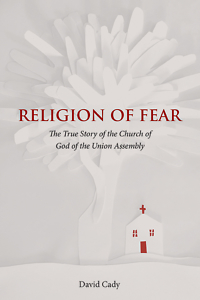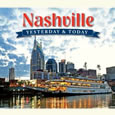All Things Foul Would Wear the Brows of Grace
David Cady explores the rise, fall, and reformation of a Pentecostal church in Religion of Fear
What are the limits of religious freedom? What differentiates a charismatic, fundamentalist religious sect from a cult? How can a faith community be rescued from its own leadership without falling apart? These are among the many questions provoked by David Cady’s Religion of Fear: The True Story of the Church of God of the Union Assembly.
 Cady begins his narrative with a dramatic moment in 1917 when C.T. “Charlie” Pratt — homeless, illiterate, a father of five, his wife Minnie pregnant with their sixth — leveled condemnation from the pulpit on the leaders of the Mountain Assembly Church before leading his young family out of the church into a blinding storm: “The seven of them — eight if you count unborn Jesse in Minnie’s womb — walked in the lightning and pouring rain two miles down the railroad track to the home of a friend by the name of Bledsoe, who would give them shelter, for they had no home. As bad as everything seemed, Charlie must have known that this event was a major turning point in his life, and it was. However, it would also change thousands and thousands of other lives.”
Cady begins his narrative with a dramatic moment in 1917 when C.T. “Charlie” Pratt — homeless, illiterate, a father of five, his wife Minnie pregnant with their sixth — leveled condemnation from the pulpit on the leaders of the Mountain Assembly Church before leading his young family out of the church into a blinding storm: “The seven of them — eight if you count unborn Jesse in Minnie’s womb — walked in the lightning and pouring rain two miles down the railroad track to the home of a friend by the name of Bledsoe, who would give them shelter, for they had no home. As bad as everything seemed, Charlie must have known that this event was a major turning point in his life, and it was. However, it would also change thousands and thousands of other lives.”
Thus began the improbable rise of the Church of God of the Union Assembly, which at its height of power in 1995 included 54 churches spread across 19 states, with some 15,000 congregants who pledged absolute loyalty to the leadership of the Pratt family. That leadership devolved into a Shakespearian power struggle when Charlie Pratt’s fourth son, Jesse, wrested power from his brothers and excommunicated his parents.
 Upon Jesse’s death, his own son, Jesse Junior, seized control of the church, ushering in an era of bizarre, cult-like obedience in which congregants made offerings not to God, but to Jesse Junior, his dead father, and his mother, Irene: “Once,” Cady writes, “Jesse Junior told the membership that he wanted a new Corvette for either his birthday or Christmas, and the faithful raised the money and got him the new sports car.” Jesse Junior maintained control through intimidation and even physical violence, threatening followers both with the dangers of hell and the presence of evil in their midst, which, ironically, only he could discern and identify.
Upon Jesse’s death, his own son, Jesse Junior, seized control of the church, ushering in an era of bizarre, cult-like obedience in which congregants made offerings not to God, but to Jesse Junior, his dead father, and his mother, Irene: “Once,” Cady writes, “Jesse Junior told the membership that he wanted a new Corvette for either his birthday or Christmas, and the faithful raised the money and got him the new sports car.” Jesse Junior maintained control through intimidation and even physical violence, threatening followers both with the dangers of hell and the presence of evil in their midst, which, ironically, only he could discern and identify.
Cady ably juxtaposes the bizarre tale of the Church of God of the Union Assembly with contemporaneous history, illustrating how easy it can be for a charismatic, power-mad leader to rise without anyone noticing anything out of the ordinary, particularly in a part of the world where Pentecostal churches are common, and no one finds anything particularly unusual in a preacher thundering about the perils of hell and the presence of demons in our midst. The depths and depravities of the Pratt family dynasty reach genuinely harrowing proportions before the inevitable fall.
Perhaps the most remarkable theme in this troubling story, however, is the resilience of faith demonstrated by the survival of the Church of God of the Union Assembly through reconciliation and reform. In its post-Pratt family incarnation, the church has resumed a comparatively moderate interpretation of the Holiness Church doctrine and continues to serve some 5,000 congregants across 12 states.
Religion of Fear is a dense text, based on extensive research, but Cady’s style is loose, not dry or scholarly. The book delivers a hair-raising story and an important one, as it opens a window into how easily a hunger for the divine can be exploited and how difficult it can be to recognize evil dressed in the garb of truth — for, as Shakespeare wrote, “Though all things foul would wear the brows of grace, / Yet grace must still look so.” As the author’s son remarks after concluding an interview with a survivor of the Pratt family’s excesses, “People have to understand evil to avoid it.”

Ed Tarkington’s debut novel, Only Love Can Break Your Heart, was published by Algonquin Books in 2016. His second novel, So Wise So Young, is forthcoming from Algonquin in fall 2020. He lives in Nashville.


